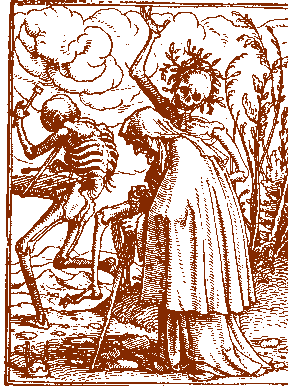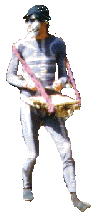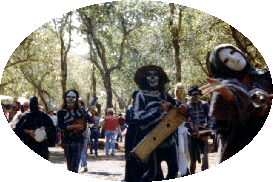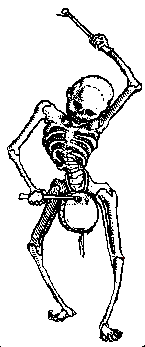
The "Bones Band" of California
|
Theme Background
From the late middle ages
through the
renaissance the church-related
phenomena known as the Dance of Death, the Dance of the Dead Ones, and
the Danse
Macabre all artistically depicted skeletons dancing and playing musical
instruments. We know that there were theatrical expressions of this
theme,
but surviving details are scarce. The more plentiful remains include
poems,
songs, woodcuts, murals, etc.
|
Genesis of the Bones Band
|

While researching percussion instruments of renaissance
Europe I
exhumed several post-mortal images, including this print by Hans
Holbein
the Younger.
Holbein had realized that the bone-rattling dance of happy skeletons
would be
a perfect fit with the sounds of percussion. As I dug deeper into the
subject
it proved to be a rich mulch of philosophical, spiritual, political,
and artistic associations. The theatrical potential was obvious, so a
course was set and embarked upon.
|
 I built instrument
replicas and variations. With a
few
friends the costumes and masks were created. In the late 1970's the
Danse Macabre, (AKA the Bones Band), was born. The original
four members were more and more regularly joined by one-time,
dead-for-a-day
volunteers and frequent dead-again drop ins. As the show gained
popularity
it grew to become a fairly long procession, with sometimes huge
re-incarnations for special occasions. Over the years the Bones Band
has enjoyed the participation of thousands of people and entertained
millions of onlookers at a variety of festive events in California.
Rumor even has it that spin-off groups have sprung up like daisies at a
graveyard in a variety of places throughout America. I built instrument
replicas and variations. With a
few
friends the costumes and masks were created. In the late 1970's the
Danse Macabre, (AKA the Bones Band), was born. The original
four members were more and more regularly joined by one-time,
dead-for-a-day
volunteers and frequent dead-again drop ins. As the show gained
popularity
it grew to become a fairly long procession, with sometimes huge
re-incarnations for special occasions. Over the years the Bones Band
has enjoyed the participation of thousands of people and entertained
millions of onlookers at a variety of festive events in California.
Rumor even has it that spin-off groups have sprung up like daisies at a
graveyard in a variety of places throughout America.
|
 Memento
mori
poetry, the murals on church walls, and even the skeleton figures that
appear in the
margins of Queen Elizabeth's personal prayer book, laid a fertlie
artistic foundation. We
join in the spirit of the Mexican Day of the Dead, (All
Souls Day), and traditions
of many other cultures in celebration of fleeting life on earth, and
respect
for ancestors in the world beyond.
After having been the Boss Bone for several years I left in
'85 to pursue other dreams.
But returning occasionally as a Dead Beat Daddy it's always a kick to
see how
the Bones Band grows and lives on. Memento
mori
poetry, the murals on church walls, and even the skeleton figures that
appear in the
margins of Queen Elizabeth's personal prayer book, laid a fertlie
artistic foundation. We
join in the spirit of the Mexican Day of the Dead, (All
Souls Day), and traditions
of many other cultures in celebration of fleeting life on earth, and
respect
for ancestors in the world beyond.
After having been the Boss Bone for several years I left in
'85 to pursue other dreams.
But returning occasionally as a Dead Beat Daddy it's always a kick to
see how
the Bones Band grows and lives on.

|

Links:
For more info on the tradition of Danse
Macabre and
photos of the Bones Band:
Still Dead: The
Northern
California Bones Band
A
Catholic Encyclopedia on "danse macabre"
Early
History:
Medieval Europe
Multi-cultural,
multi-era history
So
many examples of
Danse Macabre in art
Danse
Macabre in Film
One more from the
band
For links regarding man's general realtionship with "Death",
an index:
Optima philosophia
et sapientia est meditatio mortis
|






